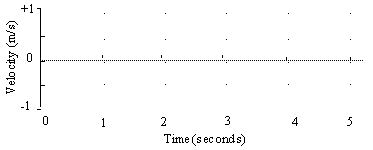
Investigation 2: Velocity-Time Graphs of Your Motion
Introduction You have already plotted your distance (position) from the motion detector as a function of time. You can also plot how fast you are moving. How fast you move is your speed . It is the rate of change of distance with respect to time. Velocity takes into account your speed and the direction you are moving. When you measure motion along a line, velocity can be positive or negative.
Activity 4 Making Velocity Graphs
1. Open the file "walking.xmbl" again. Move the mouse pointer to the Position label, click the button and select Velocity. Set the Velocity axis from -1 to 1 m/sec. To change the axis limits click on the number you want to change (a box should appear), then type in the new value and press Enter. Set the experiment to take data for 5 seconds rather than 10s. To do this select Data Collection from the Experiment menu.
2. Graph your velocity for different walking speeds and directions.
a. Make a velocity graph by walking away from the detector slowly and steadily . Try again until you get a graph you're satisfied with.
Sketch your result below. (Just draw smooth patterns; leave out smaller bumps that are mostly due to your steps.)

b. Make a velocity graph, walking away from the detector medium fast and steadily. Sketch your graph.
c. Make a velocity graph, walking toward the detector slowly and steadily. Sketch your graph.
d. Make a velocity graph, walking toward the detector medium fast and steadily . Sketch your graph.
Questions
What is the most important difference between the graph made by slowly walking away from the detector and the one made by walking away more quickly? (Q5)
___________________________________________________________
___________________________________________________________
How are the velocity-time graphs different for motion away and motion toward the detector? (Q6)
___________________________________________________________
___________________________________________________________
3. Predict a velocity graph for a more complicated motion and check your prediction.
a. Each person draw below, using a dotted line, your prediction of the velocity graph produced if you—
• walk away from the detector slowly and steadily for 10 seconds
• stop for 4 seconds
• walk toward the detector steadily about twice as fast as before
b. Compare predictions and see if you can all agree. Use a solid line to draw in your group prediction.
Prediction
4. Do the experiment. Set up the experiment to collect data for 20 seconds. Repeat your motion until you think it matches the description.
Draw the best graph on the axes below. Be sure the 4-second stop shows clearly.
Final Result
Comment How fast you move is your speed, the rate of change of distance with respect to time. Velocity implies both speed and direction. As you have seen, for motion along a line (the positve x axis) the sign (+ or -) of the velocity indicates the direction. If you move away from the detector (origin), your velocity is positive, and if you move toward the detector, your velocity is negative.
The faster you move away from the origin, the larger positive number your velocity is. The faster you move toward the origin, the "larger" negative number your velocity is. That is -4 m/s is twice as fast as -2 m/s and both motions are toward the origin.
Tools for Scientific Thinking: Motion and Force 9/92 ©1987-92 CSMT Tufts U. These activities have been modified locally: 183LoggerProLab1(Motio).doc